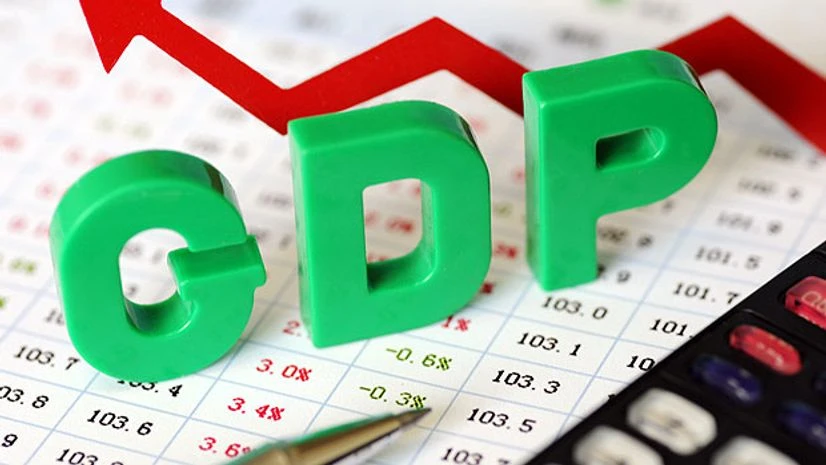
The Curious Case of GDP Data
Introduction
GK & Current Affairs for CLAT | CLAT Current Affairs 2026
Powered by CLAT Gurukul – Best online coaching for CLAT
India’s recent economic data has generated both surprise and skepticism.
The GDP growth rate for the first quarter of FY 2025-26 (April–June 2025) stood at a staggering 7.8%, making India the fastest-growing major economy in the world. The government and the Reserve Bank of India (RBI) hailed this as evidence of India’s economic resilience, even as global economies struggle with inflation and stagnation.
However, a paradox lies at the heart of this story.
If India’s GDP is growing so rapidly, why is there still sluggish consumption, weak job growth, and persistent inflationary pressure?
Why does the government continue to introduce tax cuts, consumption incentives, and welfare measures if growth is supposedly strong?
These questions have given rise to what the article calls “The Curious Case of GDP Data.”
It explores why official GDP growth appears buoyant while the on-ground economy feels sluggish, and why India’s nominal GDP (including inflation) paints a less optimistic picture than the real GDP figures suggest.
Why in News
- India’s Q1 FY2025-26 GDP growth was officially reported at 7.8%, higher than most forecasts.
- Policymakers, however, continue to announce stimulus measures and consumption boosters, such as:
- Tax cuts,
- Increased public spending, and
- Subsidy extensions.
- The discrepancy between “high growth” and “low consumer demand” has puzzled economists.
- The government attributes the growth to strong investment and public expenditure, while critics argue that private consumption remains weak, suggesting GDP numbers may not fully capture ground realities.
- This has reignited debates on data accuracy, nominal vs real GDP interpretation, and economic inequality in India.
Understanding GDP: A Refresher
- GDP (Gross Domestic Product) measures the total value of goods and services produced within a country in a specific period.
- It can be calculated in two main forms:
- Nominal GDP: Includes inflation — represents total value in current prices.
- Real GDP: Adjusted for inflation — represents actual production growth.
- A country can show high real GDP growth even if nominal growth is weak, provided inflation is low.
This is exactly the case in India right now.
The Contradiction Explained
- Real GDP vs Nominal GDP
- India’s real GDP grew by 7.8%, but nominal GDP growth (which includes inflation) was only 8.4%.
- Historically, India’s nominal GDP growth has been around 11–12%.
- This narrow gap between real and nominal GDP is unusual because it suggests extremely low inflation, which contradicts real-life experiences of rising food and fuel prices.
Quarter | Real GDP Growth (%) | Nominal GDP Growth (%) | Inflation Gap (Approx.) |
Jun 2019 | 8.4 | 11.0 | 2.6 |
Jun 2020 | -24.4 | -25.2 | 0.8 |
Jun 2021 | 33.0 | 20.5 | -12.5 |
Jun 2022 | 13.1 | 26.0 | +12.9 |
Jun 2025 | 7.8 | 8.4 | +0.6 |
(Source: CMIE & The Indian Express Research)
Thus, while headline GDP growth looks impressive, the price component of output growth—which affects real income and demand—is weak.
- The Consumption Puzzle
- Private Final Consumption Expenditure (PFCE) — which accounts for over 55% of India’s GDP — grew by only 7.0%.
- This suggests that ordinary households are not spending more, even as the economy appears to expand.
- Major indicators such as two-wheeler sales, FMCG consumption, and rural demand show stagnation.
- The paradox: growth without prosperity — the economy is expanding on paper, but not in people’s pockets.
- Investment vs Consumption
- The data show high growth in investments (Gross Capital Formation) and public expenditure, driven by infrastructure spending.
- However, this investment-led growth has not yet translated into job creation or income rise.
- Government-led growth, though necessary in downturns, cannot substitute for private demand in the long run.
- The Role of Government Spending
- Government expenditure on daily affairs (GCEC) rose by 9.7% in Q1 2025-26.
- This means much of the GDP expansion comes from public sector activity, not private economic energy.
- Hence, while GDP data shows expansion, it is government-heavy rather than market-driven.
Why Policymakers Are Concerned
Despite robust GDP figures, policymakers — including the RBI and Finance Ministry — continue to push for:
- Consumption stimulus (like tax rebates),
- Targeted welfare transfers, and
- Interest rate interventions.
Finance Minister Nirmala Sitharaman explained that with GST rates stabilizing and companies seeing better margins, demand should rise — but this has not happened as expected.
This reflects an asymmetric recovery, where:
- Urban, high-income groups thrive,
- Rural and middle-income households struggle,
- And corporate profits grow faster than wages.
An Alternative View: The Data Illusion
The article suggests that GDP may not accurately reflect welfare or prosperity.
Why?
- Overreliance on Government Expenditure:
- Growth led by government projects inflates GDP figures without improving household spending.
- Weak Tax Collections:
- Despite rising GDP, tax revenue growth remains tepid, indicating low real economic activity.
- Corporate Concentration:
- A handful of large corporations (Reliance, Adani, Tata, etc.) dominate economic growth, leaving smaller firms struggling.
- Underemployment and Wage Stagnation:
- Employment data contradict GDP optimism; real wage growth has been flat for three years.
Historical Comparison: GDP Growth Then and Now
Year | Real GDP Growth (%) | Key Features |
2019-20 | 6.5 | Strong investment, broad-based growth |
2020-21 | -6.6 | Pandemic contraction |
2021-22 | 8.7 | Base effect recovery |
2022-23 | 7.2 | Manufacturing slowdown begins |
2024-25 | 7.8 | Investment-led, consumption lagging |
The pattern shows that India’s post-COVID recovery is imbalanced, favoring investment-heavy growth rather than consumption-driven expansion.
Nominal GDP and Policy Implications
- India’s nominal GDP growth serves as the benchmark for:
- Tax projections,
- Fiscal deficit calculations, and
- Debt-to-GDP ratios.
- A lower nominal GDP means:
- Tax revenues fall short of projections,
- The fiscal deficit worsens, and
- Public debt looks higher as a share of GDP.
This complicates the government’s ability to maintain its fiscal targets.
Why the Discrepancy Matters
- Policy Design
- Economic policies — including budgets — depend on accurate GDP data.
- Overestimating growth can lead to underestimating poverty and inequality.
- Monetary Policy
- RBI’s rate decisions rely on growth-inflation balance.
- If growth is overstated, policy rates may remain tighter than needed, slowing real economic recovery.
- Voter Perception
- As India heads toward elections, “fastest-growing economy” narratives may contrast with people’s lived experience of price rise and unemployment.
Lessons from Past Trends
- The best growth quarter (Q1 2019) saw nominal GDP at 11% and real GDP at 8.4%.
That balance indicated healthy inflation and organic growth. - In contrast, Q1 2025 shows 7.8% real GDP but 8.4% nominal GDP, signaling stagnant prices and tepid demand.
- Economists warn this mismatch can lead to misleading optimism, prompting premature policy tightening.
The Bottom Line
The article concludes:
- India’s economy is growing, but unevenly.
- GDP growth is not fully translating into household welfare.
- Nominal GDP trends — not just real GDP — must guide policymaking.
- Government-led expansion must give way to private-sector and consumption-driven growth.
For students preparing with the best online coaching for CLAT or following CLAT Current Affairs 2026, this issue highlights how economic indicators can be politically interpreted and structurally misleading — a crucial understanding for interpreting policy, law, and economics.
Notes: Explanation of Key Terms
- GDP (Gross Domestic Product):
The total monetary value of all goods and services produced within a country’s borders in a given period. - Nominal GDP:
GDP measured at current market prices, including inflation. - Real GDP:
GDP adjusted for inflation; shows actual growth in production. - Private Final Consumption Expenditure (PFCE):
The total value of goods and services consumed by households — a measure of consumer demand. - Gross Capital Formation (GCF):
The total investment in physical assets such as machinery, factories, and infrastructure. - Fiscal Deficit:
The gap between government expenditure and revenue. - Inflation Differential:
The gap between nominal and real GDP growth; reflects price-level changes. - Base Effect:
A statistical phenomenon where growth rates appear high due to comparison with an unusually low base in the previous year. - Welfare Growth:
Growth that reflects improvements in people’s real incomes and living standards, not just GDP numbers. - RBI (Reserve Bank of India):
India’s central bank responsible for monetary policy, inflation control, and financial stability.
This Blog is Powered by CLAT Gurukul — India’s Leading Law Entrance Prep Platform
At CLAT Gurukul, we believe in empowering future legal minds with the right blend of knowledge, strategy, and mentorship. This blog is a reflection of our commitment to quality content that not only helps aspirants stay updated but also sharpens their conceptual clarity.
Why CLAT Gurukul?
- Personalized Mentorship by Top Legal Educators
- Comprehensive Study Materials & Legal Updates
- Daily Practice Sets, Mocks & Performance Tracking
- Result-Oriented Strategy for CLAT, AILET, and CUET
Whether you’re reading this article to deepen your understanding or to stay ahead in your exam prep — you’re already one step closer with CLAT Gurukul by your side.
Join thousands of successful aspirants who trusted CLAT Gurukul and cracked India’s top law entrance exams.
Visit https://www.youtube.com/@CLATGurukul/shorts to learn more or speak to our experts now!
Note from CLAT Gurukul
At CLAT Gurukul, we are committed to providing free CLAT study material, including CLAT current affairs, legal reasoning practice sets, general knowledge updates, logical reasoning questions, English comprehension exercises, and more — all curated by top mentors.
Our blog section is regularly updated with high-quality CLAT content tailored to match the evolving pattern of the CLAT UG exam. Whether you’re looking for CLAT 2026 current affairs, CLAT legal reasoning passages, or mock practice sets, we have you covered.
We believe in open-access learning and will continue to publish free CLAT preparation resources to help serious aspirants succeed.
Explore more free content under categories like:
Best online coaching for CLAT, CLAT current affairs, CLAT GK updates, CLAT legal updates, CLAT logical reasoning, and CLAT English preparation.
For structured learning, daily mocks, and expert mentorship, visit https://www.youtube.com/@CLATGurukul/shorts — the Best CLAT Coaching in Patna and India’s most trusted platform for CLAT online coaching.
